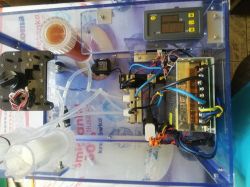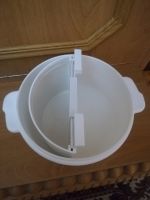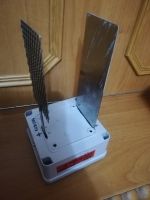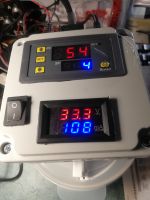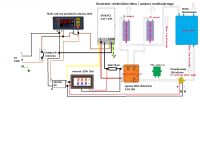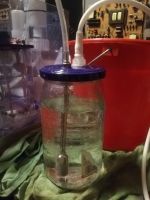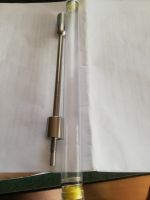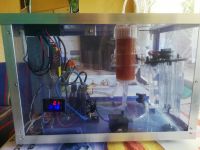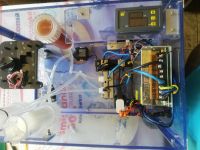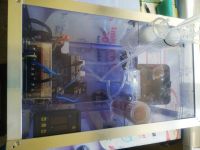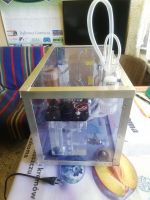.
It took me a long time to decide whether to publish this post, it also took me a little while to prepare it, so I don't know if I've drawn up everything exactly according to the "what you need" recipe. However, I decided to post it, maybe it will inspire someone or I will learn something new (hopefully not a wave of heckling: that e.g. - it doesn't work, what's the point of it, scammers, they're pulling a fast one, shamans came up with something again.... and etc.).
Molecular hydrogen generator - such a novelty that has relatively recently appeared in the offer and medicine. I will not describe here the effects of molecular hydrogen on the human body. Those interested will find everything at Uncle Google and YT. Personally, I came across a description or a video somewhere on the internet, there I found out that such hydrogen is a boon, I started digging and decided to make my own such a generator for myself. You can buy ready-made ones, but the cost is over 4 thousand. Although I counted a little, because making it out of blocks was not cheap either, and you still had to spend a lot of time.
Description:
Hydrogen generator capacity 150 ml/min. The PEM hydrogen cell produces pure molecular hydrogen for inhalation, which is separated from water in one of the gas separators. In time I realised that there are rods available for dissolving hydrogen in water, so I purchased such a rod, placed it in a jar, fed the hydrogen from the separator, which through the rod (diffuser) hydrogenates the mineral water for drinking in the jar, and at that time the other end from the jar lid is fed to the cannula, which is used for inhalation, and so I obtained 2in1 (inhalation + hydrogen water). It is recommended to pour distilled water (not demineralised water - just pure distilled water) into the diffuser jar. You can pour whatever water you like to drink into the diffuser jar. The second gas separator gives off pure oxygen, which can also be used for inhalation or mixed with hydrogen and inhaled; if not, it escapes into the atmosphere. You can skip this separator, saving a hundred and drop the tube with oxygen and water back into the decomposition water container directly (that's how those little factory generators have it). You can also skip the resin filter, saving another hundred. All in all, if you buy a container like I have, you can skip both separators, as there is already a separator in the container. You could use it for the hydrogen, and pipe the oxygen and water back into the decomposition water.
Everything bought on AliExpress, after the fact I found auctions where you could buy everything together and it would come out cheaper (ie: hydrogen cell, filter, separator, dedicated power supply - no modifications, dedicated water pump).
Costs:
The whole thing cost me around £1300-1400, so on the borderline of cost-effective.
- 150ml/20A hydrogen cell: 400 zł
- Resin filter: 100 zł
- Gas separator 2 pcs: £220 (£2x110). Although you could splurge on 1 piece, then oxygen straight into the water container
- Power supply (you need 2.1V 20A): there is a special dedicated one for different cells, costs 300 zł - I converted a 3V 40A power supply for 100 zł, there was a bit of wrangling with the conversion: https://www.elektroda.pl/rtvforum/topic3890375.html#21191459. Not to mention that earlier I bought a second 5V/70A power supply also for 100 zł, with which I didn't work out, but in the end I managed to convert the 3V/40A one, so that it gave the needed current and voltage for this cell, i.e. 20A/2.1V. I would probably buy the dedicated one next time
- Water pump with flow control: £35 (you can also buy a dedicated water pump, but the cost is approx.. PLN 100)
- Meter with 50A, 100V shunt: £20 (need not be there)
- Timer 230V AC: 20 zł (does not have to be)
- 5V phone charger (to power the meter), 230V socket: £20 (does not need to be there)
- Special water container: £140 (although here, too, could be made out of some plastic bottle and connectors). However, by using this container, you could omit both separators, saving 2 hundred pounds
- Silicone hoses and plastic connectors, jar: about 60 zł (I bought more)
- Cannula: 17 zł
- Stainless rod (diffuser) for dissolving hydrogen in water: PLN 130
- I made the enclosure from plexiglass bought at scrap price and new angle brackets from Allegro - all about £120
- 3mm screws with nuts: approx. 20 zł
Previously for live (hydrogenated) and dead water I made myself a generator based on the principle of electrolysis, which separates both waters through a membrane. I will give some pictures, but I don't want to describe it . Similar designs have been described on the electrode as well. I just wonder if the better water is the live one from electrolysis or the one hydrated by the diffuser from the jar described above. Perhaps someone will comment wisely on this subject
. Similar designs have been described on the electrode as well. I just wonder if the better water is the live one from electrolysis or the one hydrated by the diffuser from the jar described above. Perhaps someone will comment wisely on this subject  .
.
It took me a long time to decide whether to publish this post, it also took me a little while to prepare it, so I don't know if I've drawn up everything exactly according to the "what you need" recipe. However, I decided to post it, maybe it will inspire someone or I will learn something new (hopefully not a wave of heckling: that e.g. - it doesn't work, what's the point of it, scammers, they're pulling a fast one, shamans came up with something again.... and etc.).
Molecular hydrogen generator - such a novelty that has relatively recently appeared in the offer and medicine. I will not describe here the effects of molecular hydrogen on the human body. Those interested will find everything at Uncle Google and YT. Personally, I came across a description or a video somewhere on the internet, there I found out that such hydrogen is a boon, I started digging and decided to make my own such a generator for myself. You can buy ready-made ones, but the cost is over 4 thousand. Although I counted a little, because making it out of blocks was not cheap either, and you still had to spend a lot of time.
Description:
Hydrogen generator capacity 150 ml/min. The PEM hydrogen cell produces pure molecular hydrogen for inhalation, which is separated from water in one of the gas separators. In time I realised that there are rods available for dissolving hydrogen in water, so I purchased such a rod, placed it in a jar, fed the hydrogen from the separator, which through the rod (diffuser) hydrogenates the mineral water for drinking in the jar, and at that time the other end from the jar lid is fed to the cannula, which is used for inhalation, and so I obtained 2in1 (inhalation + hydrogen water). It is recommended to pour distilled water (not demineralised water - just pure distilled water) into the diffuser jar. You can pour whatever water you like to drink into the diffuser jar. The second gas separator gives off pure oxygen, which can also be used for inhalation or mixed with hydrogen and inhaled; if not, it escapes into the atmosphere. You can skip this separator, saving a hundred and drop the tube with oxygen and water back into the decomposition water container directly (that's how those little factory generators have it). You can also skip the resin filter, saving another hundred. All in all, if you buy a container like I have, you can skip both separators, as there is already a separator in the container. You could use it for the hydrogen, and pipe the oxygen and water back into the decomposition water.
Everything bought on AliExpress, after the fact I found auctions where you could buy everything together and it would come out cheaper (ie: hydrogen cell, filter, separator, dedicated power supply - no modifications, dedicated water pump).
Costs:
The whole thing cost me around £1300-1400, so on the borderline of cost-effective.
- 150ml/20A hydrogen cell: 400 zł
- Resin filter: 100 zł
- Gas separator 2 pcs: £220 (£2x110). Although you could splurge on 1 piece, then oxygen straight into the water container
- Power supply (you need 2.1V 20A): there is a special dedicated one for different cells, costs 300 zł - I converted a 3V 40A power supply for 100 zł, there was a bit of wrangling with the conversion: https://www.elektroda.pl/rtvforum/topic3890375.html#21191459. Not to mention that earlier I bought a second 5V/70A power supply also for 100 zł, with which I didn't work out, but in the end I managed to convert the 3V/40A one, so that it gave the needed current and voltage for this cell, i.e. 20A/2.1V. I would probably buy the dedicated one next time
- Water pump with flow control: £35 (you can also buy a dedicated water pump, but the cost is approx.. PLN 100)
- Meter with 50A, 100V shunt: £20 (need not be there)
- Timer 230V AC: 20 zł (does not have to be)
- 5V phone charger (to power the meter), 230V socket: £20 (does not need to be there)
- Special water container: £140 (although here, too, could be made out of some plastic bottle and connectors). However, by using this container, you could omit both separators, saving 2 hundred pounds
- Silicone hoses and plastic connectors, jar: about 60 zł (I bought more)
- Cannula: 17 zł
- Stainless rod (diffuser) for dissolving hydrogen in water: PLN 130
- I made the enclosure from plexiglass bought at scrap price and new angle brackets from Allegro - all about £120
- 3mm screws with nuts: approx. 20 zł
Previously for live (hydrogenated) and dead water I made myself a generator based on the principle of electrolysis, which separates both waters through a membrane. I will give some pictures, but I don't want to describe it
Moderated By gulson:Note that the therapy has not been scientifically proven. A mixture above 4% hydrogen with air is explosive. The topic should be regarded as a construction curiosity.
Cool? Ranking DIY






